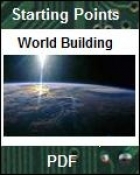Starting Points: World Building
This article was originally posted to http://www.rpg-resource.org.uk in 2010, and is reprinted with permission here and in the November 2014 issue.
 Starting
Points: World Building. Jeffrey A. Mills.
Starting
Points: World Building. Jeffrey A. Mills.
Dimensions Game Software http://www.dimensionsgamesoftware.com
PDF; 40pp
US$0.99/UKú0.62
Outside of the actual game session, one of the best bits of role-playing is the sheer creativity of it all. You can dream up literally anything—without budget constraints or regard to the skill of your special effects team—and that thing can exist within your game world. It’s even more fun to create things that actually might exist in some alternate reality, and it helps your players get into the game if your alternate reality hangs together in a plausible way. Here, then, is the purpose of this book: seed-corn of ideas to help your ideas begin to spawn as you decide upon that most fundamental part of your setting: the world itself.
The publisher’s main product lines revolve around computer tools to help the creation process… but just as the ‘book of lists to roll randomly on’ can produce strange results, so do they—and while the ‘book of lists…’ approach lets you look at the options your dice didn’t choose, computer programs spit out the one piece of data. Looking at the unselected items—or just reading a list rather than rolling dice against it—may help kick-start your own ideas and help you along the path to creating a coherent and believable world of your own.
The process presented here offers a top-down approach—beginning with things like the number of continents on your world and the number of moons orbiting it, and working through geograpical, political and social concepts to the wildlife you might encounter. Being modular, you can start at just about any point—so if you want to design just one corner of one continent, you can, leaving the rest to develop as and when you have need of it, or the time to expand your horizons. You may want a skeleton overview—there are five continents, say—even if only one will be the focus of adventure.
A good starting-point, even if the characters will never see it that way, is to visualise what your world looks like from space. (And who knows? One of my AD&D characters befriended a dragon who decided to show him that the world was round not flat and took him way, way up until the curvature of the world could be seen—then had to do a crash dive as neither of us had realised how thin the air was up there!) Even when you are only interested in one land mass, you need to decide if the people on it are even aware of any others and if so, the outline of the history of their discovery and what relationships if any exist. And it all develops from there—pertinent questions to ask yourself about first the broad strokes and then the fine detail of your world.
Once you have the geography sorted, how do the people on your world organise themselves? An interesting point is that they might have a term other than ‘country’ for whatever division of ‘nation-state’ they’ve devised, and just calling them ‘Domains’ or ‘Shires’ or something can remind your players that they are on a truly different world, an alternate reality, not just a clone of this one with point-eared fellows and magic that works. Styles of government, community sizes, the way each unit of population interacts with others… these all have a part to play in the background, even if that’s not what the action of your game will be about. A derogatory word about the wrong deity in a bar could spell disaster for a party, even if they thought they were there seeking work as dungeon clearers-out in a city with a troglodyte problem in the sewers—pity they’d not noticed it was a strict theocracy! Good basic design can spawn all manner of things (that one occured to me as I was writing… indeed, I’ll be lucky not to have a world planned by the end of the review!).
A lot of the rest of the book is made up of extensive lists of plants and animals that might be found in the locality in question. Drawback is these are all very specific Earth flora and fauna, things which, if not found in your neighbourhood, are probably in the local zoo or botanic garden, or maybe in your favourite holiday spot. Possibly a better way is to look at the ecological niches that you need to fill and come up with your own names for the creatures there—the names don’t have to be fancy, on your world maybe a ‘redleg’ is a shore-dwelling crustacean that fills the spot that a crab would occupy on Earth, so named for the hue of its limbs. Worry about what it looks like, fights like and tastes like later!
Overall this is a thought-provoking work, worth a read if you intend settling down to major world design. It won’t do the work for you, but the suggestions herein ought to start you off along the right track. And the concepts are equally applicable whether it is a fantasy or a futuristic world you require: the sole known home of a mediaeval-style society or just another port of call for a starfaring one.
 Freelance
Traveller
Freelance
Traveller